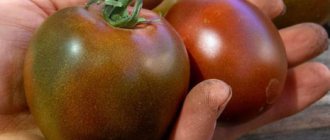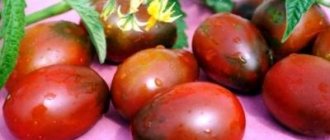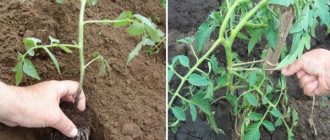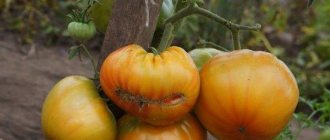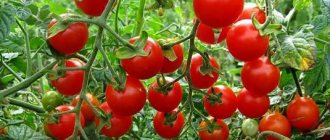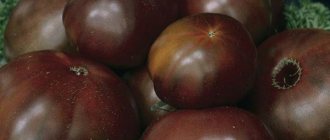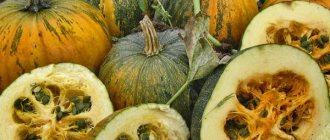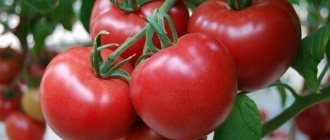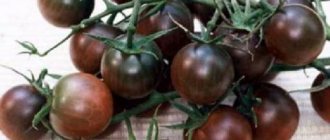Description of the variety
According to photos and reviews, the Black Crimea tomato corresponds to the following description:
- mid-early maturation;
- 69-80 days pass from planting seeds to harvesting;
- indeterminate bush;
- tomato height – 1.8 m;
- resistance to diseases.
The fruits of Black Crimea tomatoes have a number of features:
- large tomatoes weighing 500 g;
- flat-round shape;
- fleshy fruits with thick skin;
- unripe tomatoes are green-brown in color;
- during the ripening process, the fruits acquire a burgundy, almost black hue;
- high taste qualities;
- average dry matter content.
Harvesting and storage
If the plant is properly cared for and the planting instructions are followed, 4 kg of fruit can be harvested from one Black Crimea bush. To increase productivity, it is recommended to form a bush of two stems.
Tomato varieties for open ground in Crimea are usually mid-season. The fruits reach full maturity 75-85 days after sowing for seedlings or immediately in open ground.
Important! Planting in open ground is permissible only for the southern regions.
For unhindered fruiting, you will have to often go out into the garden to pick tomatoes and allow the plant to put its energy into forming new ones. Taking into account the reviews, it is not recommended to store tomatoes of the Black Crimea variety.
Boarding order
Tomato Black Crimea can be obtained by seedlings. To do this, at home, seeds are planted in small boxes. When the plants reach one and a half to two months, they are transferred to a greenhouse or an open area.
It is allowed to plant seeds directly in open ground under favorable climatic conditions in the region.
Preparing seedlings
To obtain tomato seedlings, prepare soil consisting of equal proportions of humus and turf soil. It is recommended to pre-treat the soil by heating it in the oven or placing it in the freezer. After 2 weeks, you can begin planting work.
Seed material is also processed. It is soaked for a day in warm water to stimulate the appearance of sprouts. Purchased tomato seeds have already undergone similar processing, so you can start planting them immediately.
Advice! Prepare boxes or cups 10 cm deep for seedlings.
Furrows are made on the surface of the soil to a depth of 1 cm. Seeds are placed every 2 cm. After planting, the containers are covered with glass or film, after which they are left in a dark and warm place.
According to reviews of the Black Crimean tomato, at a temperature of 25-30 degrees, seedlings appear in 3 days. If the ambient temperature is lower, growth will take longer.
The seedlings are moved to the windowsill, and constant lighting is provided for 12 hours. Water the tomatoes periodically to prevent the soil from drying out.
Planting in a greenhouse
Tomato seedlings that have reached 20 cm in height are transferred to the greenhouse. Such plants have 3-4 leaves and a developed root system.
The soil for tomatoes is dug up in the fall. The top layer of soil is removed to avoid the spread of diseases and pests in the future. Tomatoes are not grown in one place for two years in a row.
Advice! In autumn, humus or compost is added to the soil.
The Black Crimean variety is planted in rows or in a checkerboard pattern. Leave 60 cm between plants and 70 cm between rows.
To plant tomatoes, make a hole into which the root system is placed. Then the roots of the plant are covered and the soil is slightly compacted. The final stage is watering the plants.
Planting in open ground
In regions with a warm climate, seedlings of the Black Crimea variety are transferred to open ground. Reviews of the Black Crimean tomato show that these tomatoes grow well in the open air.
The planting scheme is as follows: an interval of 60 cm is maintained between plants. Tomatoes can be planted in several rows.
Advice! For tomatoes, choose beds where cucumbers, turnips, cabbage, melons and legumes previously grew.
If tomatoes or peppers were already growing in the beds, then replanting of the crop is not carried out. Compost or rotted manure is used as soil fertilizer.
In the fall, the beds need to be dug up. In the spring, deep loosening is carried out and holes are prepared for planting. Tomatoes should be transferred to open ground after warm weather sets in. The air and soil should warm up well. If the threat of cold weather remains, the tomatoes are covered with agrofibre.
You can plant seeds of the Black Crimea variety in open ground. However, it will take longer to harvest.
Characteristics of tomato Black Crimea
The variety was developed for cultivation in the Southern regions, so in countries with cold climates the plant requires shelter. The yield of the variety depends on the quality and literacy of care.
The optimal regions for cultivating the Black Crimea tomato are areas with a southern climate, where there are no temperature changes. The variety is often grown in the Belgorod and Astrakhan regions, Crimea, and Krasnodar Territory.
Black Crimea tomato yield and fruiting
Crimean black tomatoes are a high-yielding variety. From each bush you can collect from 4 to 8 kg of fruit. In terms of area, the yield is 20–24 kg per 1 m2. 5-6 tomatoes are formed in one brush. Growing is possible both in open ground and with the organization of shelter.
Climatic conditions and care have a great influence on yield: tomatoes are heat-loving and do not tolerate frost well. Fruiting also decreases if the procedures of formation and pinching are neglected.
The ripening period is different: varies from 100 to 115 days. There are cases when ripe fruits could be tasted 3 months after the seeds sprouted.
Vegetables ripen together: whole clusters
Area of application of fruits
Black Crimea tomatoes are a good option for salads and other culinary dishes. You can make delicious juice or tomato paste from them. When using this vegetable, keep in mind that it is very sweet. This feature forces gardeners to adjust recipes when preserving vegetables.
Growing tomatoes for sale is not practical: they are not transportable. Long-term storage is not possible. Gardeners do not use them for whole-fruit canning either: the size of the vegetable is not suitable for these purposes.
Resistance to diseases and pests
The variety is distinguished by its strong immunity: with timely preventive treatments, the plant does not get sick.
Without fail, care involves treating the bush against pests: aphids, Colorado potato beetles, slugs.
Tomato care
The Black Crimea variety requires constant care. This includes watering and fertilizing. Plants are watered at least once a week. Fertilizers are applied every 2 weeks.
Reviews of the Black Crimea tomato indicate that the variety is rarely susceptible to disease. For prevention, it is recommended to follow agricultural practices, avoid dense plantings, and promptly water and weed.
Since the variety is tall, it is tied to a support. To form a bush, excess shoots are pinched.
Pinching and tying
The Black Crimea tomato grows up to 1.8 m high, so it requires staking. A support made of wood or metal is installed next to each bush. As the tomatoes grow, they are tied to it at the top.
The Black Crimea variety bush is formed into one or two stems. If it is necessary to obtain large fruits, then leave one stem and normalize the number of ovaries. When tomatoes are formed into two stems, the yield increases due to the large number of fruits.
When pinching, shoots growing from the leaf axil are eliminated. The procedure allows the plants to direct their forces to the formation of fruits. The shoots are broken off by hand before their length reaches 5 cm.
Watering the plantings
Tomatoes are watered once or twice a week depending on growing conditions and weather factors. Soil moisture is maintained at 85%.
It is important to prevent the formation of a dry crust on the soil surface. Therefore, after watering, the tomatoes are loosened and hilled.
Advice! Apply 3-5 liters of water to each tomato bush.
The water must first settle and warm up. The first watering is carried out immediately after transferring the plants to a permanent place. The next application of moisture should take place in a week so that the plants can adapt to the new conditions.
Watering is especially important during the flowering period. At this time, 5 liters of water are poured weekly under each tomato. During the fruiting period, 3 liters of water is enough for tomatoes to avoid cracking of the tomatoes.
Fertilizer application
The first feeding of tomatoes is carried out 2 weeks after transferring the plants to a permanent place. During this period, you can feed the plantings with fertilizer containing nitrogen.
Add 1 tbsp per liter of water. l. urea, after which the tomatoes are watered at the root. In the future, it is not recommended to overuse nitrogen fertilizing to avoid excessive growth of green mass.
After a week, phosphorus and potassium are added. They are used in the form of superphosphate and potassium sulfide. Take 30 g of each substance per bucket of water. Watering is done at the root.
Advice! During the flowering period, tomatoes are sprayed with a solution of boric acid (1 g of substance per 1 liter of water).
Repeated feeding with superphosphate is carried out when the fruits ripen. Take 1 tbsp per liter of water. l. this component. Plantings are sprayed with the resulting solution.
Features of cultivation, planting and care
We recommend sowing the seeds of this tomato for seedlings 60-65 days before the intended planting in the ground. Seedlings dive at the stage of two true leaves. When planting seedlings in a permanent place per 1 sq. It is recommended to place no more than 3 plants per meter of land; when forming into 1 stem - up to 4.
Further care for tomatoes consists of timely watering (we recommend installing a drip system), weed removal, pinching, fertilizing with complex mineral fertilizer and preventive measures to protect the crop from diseases and pests.
Currently, you can find seeds of this variety on sale from the company Euro-seeds; they call this tomato Crimean Black. We purchased the seeds of this exotic tomato from reliable collectors - Valentina Redko and Ilya Korolev (Royal Garden). In both cases, seed germination was 100% and subsequently the plants and fruits fully corresponded to the variety.
You can see other interesting varieties and hybrids of tomatoes with photos, descriptions and reviews in our Tomato Catalog. Enjoy watching.
Reviews from gardeners
Svetlana, 37 years old, Stupino
The variety Black Crimea pleased with its high yield and beautiful appearance. Dark fruits look original in salads due to their burgundy-brown hue. The tomatoes grew large and very tasty. I have already grown other black-fruited tomatoes, but Black Crimea definitely surpassed them in taste.
Arina, 54 years old, Irkutsk
Tomatoes Black Crimea conquered with their unique taste. I grew the variety in a greenhouse and there were no problems with the ovary. The fruits ripened on the bushes. All tomatoes have a smooth surface and a rich burgundy color. The minimum fruit weight was 300 g; there were no small tomatoes. I will definitely plant this variety next year.
Evgeniy, 60 years old, Nizhny Novgorod
I became interested in the Black Crimea tomato based on reviews and photos. As a result, I bought seeds from which I obtained seedlings. In the greenhouse, the height of this variety of tomatoes was 1.5 m. The plants are very powerful and strong, the fruits ripen early. The variety pleased with its productivity: the largest tomatoes weighed 750 g, there were many fruits weighing 400 g. The tomatoes tasted ordinary, although the family and children liked them.
Diseases and pests
The above-mentioned variety of tomatoes is practically not susceptible to diseases, and treatment with insecticidal preparations will help protect your garden from pests.
If you have long dreamed of black-fruited tomatoes, pay attention to “Black Crimea”. Large fruits of unusual color will surprise you with their unsurpassed taste, and growing these tomatoes will not require much trouble from you.
And in the table below you will find links to articles about tomatoes of various ripening periods that may be useful to you:
| Super early | Mid-season | Mid-early |
| White filling | Black Moor | Khlynovsky F1 |
| Moscow stars | Tsar Peter | One hundred poods |
| Room surprise | Alpatieva 905 a | Orange Giant |
| Aurora F1 | Favorite F1 | Sugar Giant |
| Severenok F1 | La La Fa F1 | Rosaliza F1 |
| Katyusha | Right size | Em Champion |
| Labrador | Dimensionless | Sultan F1 |
If you find an error, please select a piece of text and press Ctrl+Enter.
Features of the region
The south of Russia is a huge territory, including territories and regions with different types of climate. Temperate continental, mountainous, subtropical - variations alternate with each other, with sudden changes in weather typical. Summers are long and hot, winters are humid, with frequent thaws and slight cold. The average temperature in winter, for example, according to indicators in the Krasnodar Territory, is about +7ºC, although it can be higher.
Tomatoes are grown everywhere, sowing seeds directly into open ground. Due to the specific climate, it is necessary to select varieties that are resistant to drought and high temperatures.
In areas with low rainfall, it is important to provide irrigation systems. Drip equipment is mainly used, which is economical and has the ability to deliver moisture only to the roots of plants.
Gardeners often grow tomatoes on ridges to retain moisture in the soil and avoid overheating of the plant's root system. Minimal tillage and no-moldboard plowing are practiced.
Super early Dutch tomatoes The climate in Holland is harsh. In July, the average daily temperature does not exceed 17 °C. Dutch breeders have developed many productive tomato varieties for protected soil. They can be grown in greenhouses...
Advantages and disadvantages
Excellent taste is one of the main advantages of this variety. Ripe tomatoes are aromatic and sugary. The purpose of the tomato is salad. The harvest is used mainly for fresh consumption. Can also be used for cooking and processing into tomato products.
Tomatoes have other advantages:
- is relatively early ripening;
- considered a productive variety;
- has an extended fruiting period;
- differs in large fruit.
Attention! The fruits of Crimean Night tomatoes are large, so they are not suitable for whole-fruit canning, since they do not always fit into the neck of the jar.
The negative aspects include the disadvantages inherent in generally indeterminate tomatoes. The existing disadvantages, if they can be called such, are more related not to the variety itself, but to the characteristics of cultivation:
- Tall tomatoes require a garter to a trellis or other strong support.
- Plants must be inspected regularly, cutting off excess shoots in a timely manner. Without this procedure, tomato bushes quickly thicken, and the fruits are smaller than the size stated by the manufacturer.
Tomato 'Black Crimea' - sweet tooth, pay attention!
Several years ago, while looking through tomato varieties from famous breeders, I became interested in the 'Black Crimea' variety. Reviews about it were very good - they promised good yield and excellent taste.
The history of the appearance of this variety is interesting. In the 90s, a certain Lars Rosentrom, a Swedish breeder, was vacationing in Crimea. He noted the delicious black Crimean tomatoes and brought them to Europe. Then in the USA this variety becomes one of the ten most delicious varieties and only after that it begins to be actively cultivated throughout Russia.
The variety 'Black Crimea' is indeterminate, mid-early. Fruits weighing 300-500 g, flat-round in shape. During the ripening period, the tomato changes color from greenish-brown to purple-burgundy. The skin is dense, but can burst if there is excess moisture.
Like all indeterminate varieties, I sow the 'Black Crimea' tomato for seedlings in late February - early March. This year I sowed on February 28th.
First, I disinfected the seeds. I dipped the seeds in a fabric bag into a solution of potassium permanganate for 20 minutes and then washed them with clean water. After that, I soaked the bag in the Epin solution for several hours. The solution was drained, moistened with clean water and the seeds were kept warm for a day, near a heating radiator. Next, the seeds were hardened in the refrigerator for 2 days, and then planted in a box with Terra Vita soil with the addition of vermiculite. I usually cover the box with film and place it close to the battery. After the shoots appear, I transfer them to the windowsill. The grown seedlings were planted into separate pots.
Seedlings 'Black Crimea', end of March
The fruits begin to ripen by July 20. It is better to tie the brushes, as they can break under the weight of the fruit.
24.07.2018
'Black Crimea' lives up to its purpose - salad. It tastes sweet, juicy, meaty. The average weight of a tomato is about 300 g. There are 5-6 fruits in a brush.
Weight
The cut reveals the “sugar” essence of this tomato, small seed chambers.
Incision
Brief information about the variety
- Fruits and bush: the plant is indeterminate, the bush is standard and stable. Fruit weight - up to 500 g. The color is dark burgundy, the texture is dense. The taste is sweetish.
- Productivity: up to 6 kg is harvested from 1 bush, up to 23 kg from 1 m².
- Resistance: not afraid of high temperatures, but not resistant to the main diseases of the Solanaceae genus. Does not require abundant watering.
- Distribution: grow in greenhouses in the southern and middle regions of Russia.
- Application: used fresh for preparing salads or processed into winter preparations.
- Planting: grown in greenhouses. Planted in early May. Scheme: 3-4 bushes per 1 m².
- Soil: sandy loam soil is optimal.
- Care: watering as needed. Fertilizers are applied 3-4 times per season. The bush is formed into 1-2 stems. The soil is periodically loosened and weeds removed.
- Ripening period and storage: The fruits ripen at the end of June. The fruiting period lasts about a month. Tomatoes do not store well (4-5 days) and are prone to cracking.
Growing seedlings
Black Crimean tomatoes develop better if they are planted through seedlings.
After sowing, 50-60 days should pass to transplant the sprouts into the ground. Sowing occurs in late February–early March.
Seed preparation
Buy quality seeds from trusted suppliers. Those that have been lying around for more than 2 years will not sprout (they are overdried and empty), so it is necessary to check the expiration date.
Tatyana Orlova (Vasilidchenko) (candidate of agricultural sciences):
Tomato seeds remain viable for an average of 5-6 years after collection. Under favorable storage conditions, they can sprout in 8-10 years.
They are soaked in salted water for 20-30 minutes, and then placed in a damp cloth (only natural) or napkin so that the seeds hatch. The fabric is periodically moistened to prevent it from drying out.
Tatyana Orlova (Vasilidchenko) (candidate of agricultural sciences):
In a salt solution, the seeds are divided into 2 fractions. Full-weight seeds suitable for sowing sink to the bottom. The puny ones remain on the surface.
The seeds are hardened: left in the refrigerator for 12 hours, and then kept at room temperature for 12 hours. This is repeated for 7-8 days.
Disembarkation scheme
The soil is prepared as follows: 2 parts peat, 1 part humus and 1 part rotted sawdust. Seeds are sown in containers to a depth of 1.5-2 cm.
It is more convenient to use peat pots, which do not need to be removed when transplanting into greenhouses. Plain plastic cups will also work.
Before emergence, the containers are kept in a warm place (22-25°) and covered with transparent film or glass to keep the soil from drying out.
Seedlings are planted when 2-3 true leaves are formed. When replanting the sprout into a larger container, you need to try not to damage the roots, they are still unformed and fragile.
2 weeks after rooting the seedlings, the first fertilizers are applied. Special fertilizers for seedlings are suitable: Aquarin, Crystallon, Mortar.
Advantages and disadvantages of the variety
Taste when ripe is the main advantage of tomatoes. The structure of their pulp, taste and aroma make it possible to prepare fresh or canned salads, pickle or cover the crop, grind it into paste, juice or sauce. Other positive characteristics of the variety declared by the breeders:
- An increased proportion of the beneficial substance lycopene compared to other tomatoes.
- Overall yield is above average. 3-4 kg are removed from the bush per season.
- There are no more than 10-20% of low-quality tomatoes on the branches.
- Extended fruiting. The plant is ready to set fruit before frost. Gardeners need to trim the stems in advance in order to have time to harvest ripe tomatoes.
- Good keeping quality. Normal transportability.
- Reduced susceptibility to most diseases.
- Unpretentious cultivation. Resistance to climate stress.
Disadvantages of tomato:
- the need for removal of stepsons, formation;
- need for garter.
Attention! There are few seeds in the tomato pulp. This is a positive trait for gourmets, but a negative quality for those who want to propagate the variety.
Distinctive features of black-fruited tomatoes
Chokeberry varieties stand out among other tomatoes with a special color, piquant taste and a specific set of useful substances.
Anthocyanin color
The intense dark shade of the fruit is given by special organic pigments - anthocyanins. Modern science suggests that these natural substances have biological activity and may be beneficial to human health.
Photo: Variety De Barao black
Benefits of anthocyanins:
- improve the barrier functions of the gastrointestinal tract, reduce its inflammation;
- reduce the risk of developing tumors of the esophagus, intestines and other organs;
- have a positive effect on the prostate gland and men’s health in general;
- have a beneficial effect on vision;
- reduce oxidative damage to cells and blood vessels.
It is likely that eating natural foods rich in anthocyanins slows down the overall process of human aging. In addition, dark fruits contain a large set of vitamins, organic compounds and mineral elements typical of all tomatoes (vitamins A and C, lycopene, rubidium, etc.).
Potential Harm
The benefits and harms of black-fruited varieties are a studied issue. The danger rarely arises only for people prone to allergies.
Their body (especially children’s) can react negatively to both anthocyanins and the toxic glycoside solanine, which is present in small quantities in unripe tomatoes. Ripened fruits are less allergenic.
Specific taste
Photo: Variety Kumato
Most black-fruited varieties have a different ratio of organic acids and sugars (glucose, sucrose) than other tomatoes. They are especially sweet, with a fruity and spicy aftertaste.
To some this seems unusual, but to others it delights.
Use of fruits
Summer residents grow Black Crimea primarily for fresh consumption. It is also believed that tomatoes of this variety are excellent for preparing summer salads.
The fruits of the Black Crimea are large in size. Therefore, in their entire form, they are not pickled or salted. In addition, during heat treatment, the skin of the fruit may burst. When preparing vegetables for the winter, the fruits of this variety are usually used only for making juice and ketchup.
Growing tomatoes
“Black Crimean” feels best in its native climate – in warm, sunny regions with long summers. However, its rapid ripening allows it to be grown in open ground even in the middle zone. The variety is suitable for cultivation by any method: both seedlings and non-seedlings.
How to prepare seeds?
Seeds are collected from fruits whose appearance most closely matches the nominal value. The bushes on which they grew must be strong and healthy. Having finely chopped and crushed the fruits into a paste, they are left in a glass jar until fermentation begins, then removed, washed and thoroughly dried.
To increase germination and improve the quality of seedlings, it is necessary to carry out complete pre-sowing treatment. It includes the following steps :
- Warming up for several days at a temperature of 40-50*C;
- Inspection and rejection of damaged, moldy or unevenly colored seeds;
- Soaking in a weak saline solution to identify empty seeds;
- Etching with a solution of potassium permanganate (10 mg per 50 ml of liquid);
- Growth stimulation with the help of special preparations: “Epin-Extra”, “Zircon”;
- Soak in water at room temperature for several hours before planting.
Sowing seed material
Sowing of seedlings is carried out in the last ten days of April - early May. Seeds are sown in open ground in early June, when the soil warms up to at least 15*C.
There are two ways to sow seedlings:
- Traditional;
- Fast.
Traditional way
Fertilized substrate is poured into a standard container for sowing, paths are made 1-1.5 cm deep and seeds are placed in them every 2 cm. Having leveled the ground and thoroughly moistened with warm water, the seedlings are covered with transparent polyethylene until the seeds hatch. Then they are opened and transferred to a well-lit place with a temperature of 22-24*C.
At the stage of the appearance of the second leaf, the plants are planted in separate containers. It is advisable to use a container for this from which you will not need to remove them when moving to a permanent place. For example, paper glasses or peat pots.
Fast way
A large wooden box with a depth of at least 10 cm is used as a container. The seeds are buried in the ground in a square-cluster manner every 10 cm. After sowing, the ground is sprayed with “Humate” from a sprayer, and the seedlings are taken out to a glazed balcony or greenhouse. The top of the box is covered with non-woven material (but not film). After the emergence of seedlings, the shelter is removed and placed only at night to protect against hypothermia, or in rare cases during the day - to protect from the scorching sun. No picking required.
IMPORTANT : “Black Crimea” does not like dense plantings - ventilation is disrupted, plants do not receive enough solar energy, the nutritional zone is reduced and, as a result, yields fall.
Rules for planting seedlings
Seedlings that have reached the age of 35-45 days are planted in a permanent place. In the south, planting is carried out at the end of May, in the middle zone - no earlier than mid-June.
Approximate disembarkation scheme:
- The depth of the planting holes is 12-15 cm;
- The distance between bushes is 50 cm;
- Row spacing is 70 cm.
